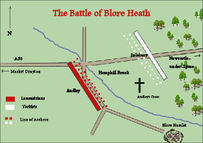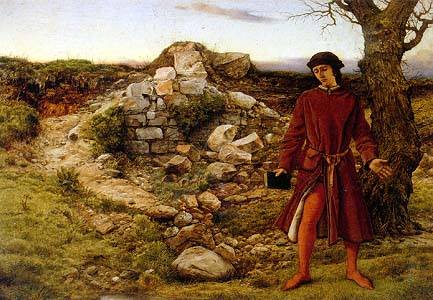It comes as no surprise that such a high state of tension would eventually come to blows, and it did at St Albans in the May of 1455. St Albans is considered by some to be the first battle of a civil war that has come to be known as the Wars of the Roses.
In a battle that lasted just one hour, a number of notable Lancastrian nobles including, Henry Percy, Thomas Clifford, and Edmund Beaufort were killed. After the battle Henry VI was captured, Richard, Duke of York assured Henry of his loyalty and along with the Earl of Warwick accompanied the king to London. Just under two months later, at the beginning of July, the king opened Parliament and following that, Henry, along with his Margaret of Anjou and their son were moved to Hertford Castle. That November saw the Duke of York appointed as Protector for a second time, and just like the first protectorate it was short, it ended in the last week of February 1456, but York remained an important member of the Royal Council. However, three very troubled years ensued, and at the end of which the Duke of York, with Richard Neville as his enforcer, would make his play for the crown of England.
In those intervening years, two battles took place The Battle of Ludford Bridge in the October of 1459 and the Battle of Blore Heath on the 23rd September 1459, where Margaret of Anjou is said to have watched from the tower of a local church.
The Earl of Salisbury, which knew the sleights, strategies and policies of warlike affairs, suddenly returned, and shortly encountered with the Lord Audley and his chief captains, ere the residue of his army could pass the water. The fight was sore and dreadful. The earl desiring the saving of his life, and his adversaries coveting his destruction, fought sore for the obtaining of their purpose, but in conclusion, the earl's army, as men desperate of aid and succour, so eagerly fought, that they slew the Lord Audley, and all his captains, and discomfited all the remnant of his people...
Three months later the wheel of fortune would turn again this time favouring Henry VI's forces. On the 12th October, the Yorkists regrouped at Ludford Bridge but discouraged by the size of the Lancastrian army they retreated when they found themselves opposite their enemy across the River Teme. During the night many of York's army deserted, and this was followed by a retreat the next morning, the Duke of York and his son Edmund of Rutland headed for Ireland, Richard Neville, his father and York’s eldest son Edward, later Edward IV fled to Calais.
Following Blore Heath John Sutton, Audley's commander was captured but later released and eventually made Treasure of Henry VI's household. He was a survivor of the Wars of the Roses, in later years he was pardoned by both Edward IV and Henry VII.
The Yorkist leader, the Earl of Salisbury, would lose his life just over a year later at the Battle of Wakefield.
.
.










 RSS Feed
RSS Feed
